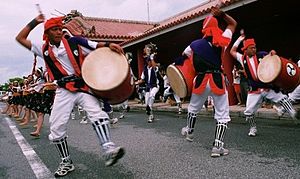Eisa (dance)

Eisa (エイサー, Eisaa) is a form of folk dance unique to the people of the Ryukyu Islands. Although it is performed many times throughout the year at various festivals, Eisa performances are concentrated around lunar mid-July. This is a centuries-long tradition, to mark the end of the Obon Festival.
It is danced by 20-30 young men and/or women, mainly in a circle to the accompaniment of singing, chanting, and drumming by the dancers, and folk songs played on the sanshin. Three types of drums are used in various combinations, depending upon regional style: the ōdaiko (大太鼓), a large barrel drum; the shimedaiko (締太鼓), a medium-sized drum similar to ones used in Noh theatre; and the paaranku (パーランク), a small hand drum similar to ones used in Buddhist ceremony. The dancers also sometimes play small hand gongs and yotsutake castanets. Eisa dancers wear various costumes, usually according to local tradition and gender of the dancer; modern costumes are often brightly-colored and feature a characteristic, colorful Ryūkyū-style knotted turban. Special vests and leggings are also popular.
History
The Eisa originated from a group dance called esa omoro, to which Buddhist songs and dances were later added. The primary theory on the dance's name is that it is derived from the word "Esa", from the line "Iro Iro no Esa Omoro" in volume 14 of Okinawa's "Omorosoushi", or book of ancient poems. "Eisa" was a refrain in Buddhist prayers for the dead. Though regarded today as entertainment, the Eisa originally had an important religious function of giving repose to the dead. An Eisa performance on street corners and at homes of villagers was comparable to performing a memorial service for village ancestors. Thus, the Eisa dance always began with songs, particularly of the Joudo sect, which invoked the Buddha. These songs were called "nembutsu" songs, and sung by wandering priest-substitute minstrels (ninbuchaa) and, later, priests themselves; some examples of these songs include "Mamauya Nembutsu", "Chouja nu Nagari", and "Yamabushi". Just as Buddhist priests used these songs to popularize Buddhist teachings, so did Ryūkyū musicians begin use Eisa dancing to popularize Ryūkyū music by replacing the Buddhist prayers with folk songs, which remain popular for Eisa accompaniment. (Ooshiro, 14, 28)
Works cited
- Eisaa by Manabu Ooshiro, trans. by Marie Yamazato. Yui Publishing Co. for Okinawa Department of Culture and Environment, Cultural and International Affairs Bureau, Culture Promotion Division, Naha City, 1998.
See also
- "Obon Festival" at Ryūkyūan religion.
External links
- Eisa Picture at HDR Japan. Okinawa Living Photographer image of Eisa in Okinawa Japan
- Eisa Dancing at Wonder-Okinawa. An detailed resource for very specific information.
- Eisa dance troupe performing block-to-block in a neighborhood in Chatan, Okinawa.
